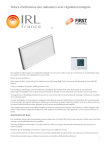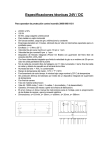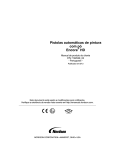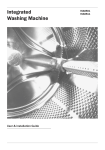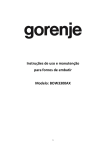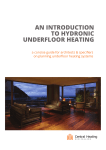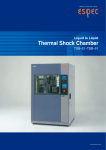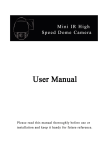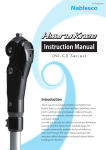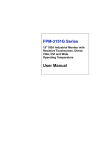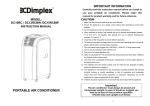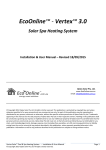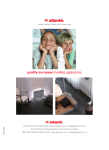Download Infrared Panel Heater with Wireless Thermostat
Transcript
Infrared Panel Heater with Wireless Thermostat “Frame WIST” Series W 30/60/90/120/150 INSTALLATION AND OPERATION MANUAL-2011-WIST-v3-eng 1 CONTENTS 1. PRODUCT SPECIFICATIONS.................................................................................................................................. 3 2. PACKAGE CONTENTS............................................................................................................................................ 3 2.2. ASSEMBLED HEATING PANEL ............................................................................................................................... 3 2.3. THERMOSTAT ...................................................................................................................................................... 4 3. INSTALLATION ........................................................................................................................................................ 4 3.1. FIRST-TIME SETUP .............................................................................................................................................. 4 3.2. SETTING THE TIME AND DATE ............................................................................................................................... 4 4. FUNCTIONALITY SETS ........................................................................................................................................... 5 5. SERVICE MENU (PR1 – PR15)................................................................................................................................ 5 Pr 1 LCD Backlight .............................................................................................................................................. 5 Pr 2 Switch between 7+0 and 5+2 programs ....................................................................................................... 5 Pr 3 Optimal start................................................................................................................................................. 5 Pr 4 Regulation type ............................................................................................................................................ 5 Pr 5 ON-OFF regulation hysteresis parameter .................................................................................................... 6 Pr 6 P constant of PI regulator............................................................................................................................. 6 Pr 7 I constant of PI regulator .............................................................................................................................. 6 Pr 8 Product firmware version ............................................................................................................................. 6 Pr 9 Reset to factory defaults .............................................................................................................................. 6 Pr 10 Pairing and unpairing panel(s) to a thermostat ............................................................................................ 6 Pr 11 Display temperature in Celsius or Fahrenheit scale ..................................................................................... 7 Pr 12 Frost guard................................................................................................................................................... 7 Pr 13 Frost guard threshold ................................................................................................................................... 7 Pr 14 Temperature sensor calibration .................................................................................................................... 8 Pr 15 Thermostat functionality set ......................................................................................................................... 8 6. LED INDICATOR (PANEL STATUS) ........................................................................................................................ 8 7. RAPID HEATING & ECO MODE .............................................................................................................................. 8 8. KEYPAD LOCK ........................................................................................................................................................ 8 9. THERMOSTAT BATTERY ........................................................................................................................................ 8 10. THERMOSTAT MODES ....................................................................................................................................... 8 10.1. MANUAL MODE ................................................................................................................................................... 8 10.2. AUTO MODE ....................................................................................................................................................... 9 10.3. AUTO + MANUAL MODE ....................................................................................................................................... 9 10.4. HOME MODE ...................................................................................................................................................... 9 10.5. HOME + MANUAL MODE ...................................................................................................................................... 9 10.6. HOLIDAY (AWAY) MODE ....................................................................................................................................... 9 11. SCHEDULED HEATING PROGRAMS................................................................................................................. 9 11.1. AUTO MODE ( ) - WEEKLY PROGRAMMING .................................................................................................. 9 11.2. HOME MODE ( ) - DAILY PROGRAMMING ..................................................................................................... 10 12. CHANGING THE TIME AND DATE ................................................................................................................... 10 13. TURNING OFF THE PANEL & THERMOSTAT ................................................................................................. 10 14. SAFETY NOTES ................................................................................................................................................ 11 MANUAL-2011-WIST-v3-eng 2 1. PRODUCT SPECIFICATIONS: Model Number W30 596mm x 296mm x 58mm W60 596mm x 596mm x 58mm W90 596mm x 896mm x 58mm W120 596mm x 1196mm x 58mm W150 596mm x 1496mm x 58mm Max. Wattage 500W 500W 800W 1000W 1300W Panel Weight 4.5 kg 7.2 kg 10.2 kg 13.2kg 16.2 kg 4.4A 5.7A Dimensions* Input Power 230V~ 50-60Hz Current 1A 2.2A Power Cable 3.5A Length 2m with Earthed connection plug Glass Tempered glass or tempered mirror - Max. surface temperature 125°C Frame Aluminum profile Effective Area 6m2 10m2 15m2 20m2 25m2 * Assembled dimensions, with mounting hardware for wall/ceiling 2. PACKAGE CONTENTS: Wireless Thermostat Heating Panel Screws/ plugs for wall (x4) Power Cable (2m) Washers (x4) Mounting bracket screws (x4) Screws/ plugs for thermostat (x2) Mounting Brackets (x4) Thermostat back cover (x1) Installation Template 10mm wrench (x1) 2.2. Assembled Heating Panel Back view. The front heating surface is tempered safety glass surrounded by aluminum framing LED Indicator On / Off Switch Panel Identification Number Electronics / Antenna Housing Mounting Brackets Power Cable Power Cable Socket MANUAL-2011-WIST-v3-eng 3 2.3. Thermostat 3. INSTALLATION: The heater should not be obstructed by or placed behind furniture or other objects (see also safety notes). Because of its IP rating (IP50), when installing in bathrooms or kitchens, the panel must be placed at a position where it will not come into contact with water (see Safety notes, page #10). The heater should be installed at a position where occupants would normally be at the same distance from it. Once the most favorable installation position has been identified, please follow these steps: Step 1: Place the installation template on the wall using tape, ensure that it is level, and mark the 4 locations of the holes for the wall plugs and mounting screws. Verify that there are NO electrical cables in the wall where you will be drilling. It is also advised to choose a location for the panel where there is no metal content or electrical cabling 10cm or less from the plastic housing of the electronic components (this contains the antenna). Step 2: Use a drill bit suitable for the wall material type. For concrete/ brick walls, use a drill with a diameter of 8mm. Step 3: Put the wall plugs in the holes and fix the screws until the head of each remains about 1 cm from the wall. Plugs for solid (concrete, brick) walls are provided. In case of doubt, please ask for assistance from a professional. Step 4: Hang the panel using its mounting brackets on the screws, and then close the 2 security tabs for added safety. Be sure that the power cable does not cross over the rear component box. This may in some cases cause a lower reach in distance of signals between the thermostat and heating panel. Step 5: Remove the back cover from the thermostat and then remove the paper which separates the battery from its (+) contact terminal. Replace the cover and secure it with the smallest screw provided in the bag of mounting screws. Plug the power cord of the panel into a standard electrical wall outlet. 3.1. First-time Setup: The heating panel and thermostat supplied in each box are paired (pre-assigned) to function together at manufacture. Follow the pairing / unpairing procedure under Pr 10 in the Service Menu (page #6) only if necessary – for example when pairing 2 or more panels to one thermostat. 3.2. Setting the Time and Date: When the battery is inserted back into the thermostat, all elements on the LCD will display briefly. “Time” will then appear and the flashing elements for HOUR, MINUTE, DAY, MONTH and YEAR can be increased or decreased with the or keys, then confirmed with the key as illustrated in the sequence below (see also section 12, page #10): Afterward, the default mode is (manual), the default set temperature is 20°C and thermostat functionality is in “SIMPLE” functionality (example at right). Rapid heating is also enabled by default – indicated by the symbol. To the right, 23.4°C is displayed on the LCD, but this is only an example of real room temperature, not the set temperature. The desired room temperature can be viewed or changed by pressing the or keys. MANUAL-2011-WIST-v3-eng 4 4. FUNCTIONALITY SETS: After initial start-up, SIMPLE functionality is enabled by default. There are two types of functionality sets: SIMPLE functionality set - without the option to schedule ENHANCED functionality set means that all functions heating programs. The thermostat has limited functions on the described in this manual are enabled and may be modified. main screen. The user sets the temperature with or in / / . (manual) mode. This is similar to using a normal type AUTO, HOME, AWAY, All 15 parameters in the Service Menu may be edited (Pr1thermostat with a control dial. Pr15). (MAX mode) is also active by default and uses the maximum power capacity of the heating panel until the desired ECO Mode – energy saving mode, uses 50% power (see section 7, page #8) temperature is reached (see section 7, page #8). Other functions in SIMPLE functionality are: • energy saving mode with possibility of time&date adjustment (section 12) • service menu with access to most of its sub-functions (see sections 5) *** To switch between the 2 functionality sets, use parameter 15 (see Pr 15, page #7) *** 5. SERVICE MENU (Pr1 – Pr15): The purpose of this menu is the full configuration of the thermostat parameters. (Note: The parameters are pre-configured for optimal usage, with the exception of pairing and un-pairing - Pr10.) The service menu is activated by holding down for 5 seconds. To save the changes to any setting and exit, use the same combination (hold for 5 seconds), or press the button to save the setting change and then move on to the next menu item. If no button is pressed, the menu automatically turns off after 1 minute and the new setting will be saved. 5 seconds Pr 1 LCD Backlight [0]=OFF, [1]=ON / default: [0] With this option turned on, the LCD background will light up for 5 seconds after any keypress. Activation of backlighting reduces battery life. *ACCESSIBLE ONLY IN ENHANCED FUNCTIONALITY* Pr 2 Switch between 7+0 and 5+2 programs 5 seconds, x1 5 seconds, x2 5 seconds, x3 [0]=7+0 and [1]=5+2 programs / default: [1]: 7+0 is to set different temperature schedules for every day of the week. 5+2 is to set temperature schedules for weekdays, and another for weekends (default). ***SEE PAGE #9 CHAPTER 11 FOR INSTRUCTIONS*** *ACCESSIBLE ONLY IN ENHANCED FUNCTIONALITY* Pr 3 Optimal start [0]=OFF, [1]=ON / default: [0] “Optimal start” - when set to [1] = ON, the system can start heating in advance to reach the desired temperature on time. For instance, if the user has 22°C set for 7 am, normally the thermostat will send signals to the panel to start heating at 7 am. When “Optimal start” is on, heating will begin in advance to reach the desired temperature on time; 22°C at 7 am in this case. The thermostat has a built-in algorithm to start heating at the optimal time in advance in order not to overheat the room. Pr 4 Regulation type [0]=ON/OFF and [1]=PI regulation / default: [0]: If set to [0], classic ON-OFF regulation with set hysteresis (see parameter Pr5) is used. If set to [1], PI regulation is used (see Pr 6 and 7). Hysteresis regulation at times exceeds and falls below the desired temperature in a gradually narrowing cycle until the desired temperature is reached. PI regulation also ensures an almost constant temperature, but in contrast to hysteresis regulation, it is reached by gradually increasing the temperature to its desired level at specified increments. MANUAL-2011-WIST-v3-eng 5 Pr 5 ON-OFF regulation hysteresis parameter defaults: [0.2°C / 0.4°F] This setting defines temperature increments at which the thermostat controls the heating panel and monitors room temperature. It may be set from 0.1°C to 10°C at an accuracy of 0.1°C. If the Fahrenheit scale is used, the value may be changed from 0.2°F to 18°F at an accuracy of 0.2°F. The default settings are optimal in most cases and should not be modified without professional consultation. 5 seconds, x4 Pr 6 5 seconds, x5 5 seconds, x6 5 seconds, x7 5 seconds, x8 P constant of PI regulator defaults: [30 - Celsius / 54 - Fahrenheit]: May be set from 0.0 to 55.0 when using the Celsius scale, or from 1.8 to 99.0 when using the Fahrenheit scale. Temperature scales are modified under parameter 11. The default settings are optimal in most cases and should not be modified without professional consultation. Pr 7 I constant of PI regulator defaults: [1 - Celsius / 1.8 - Fahrenheit]: May be set from 0.0 to 55.0 when using the Celsius scale, or from 1.8 to 99.0 when using the Fahrenheit scale. Temperature scales are modified under parameter 11. The default settings are optimal in most cases and should not be modified without professional consultation. Pr 8 Product firmware version The thermostat firmware version will display when the user reaches parameter 8. To leave the menu press . Pr 9 Reset to factory defaults After setting this parameter to [1], all values that have been modified by the user and stored in the thermostat's memory will be cleared, including control of any previously paired panels. The thermostat will operate as new, set back to its factory default parameters. Pr 10 Pairing and unpairing panel(s) to a thermostat The thermostat and panel which are supplied together in the box have already been paired at manufacture. Follow the instructions here when pairing an additional panel to a thermostat. One thermostat may control up to 10 heating panels. Each panel has a unique 8-digit label (panel ID number) which is located on the plastic cover of the control unit on the panel rear (eg: 00-00-20-C3). The pairing process is only possible if both the thermostat and panel are turned on. First, the thermostat will search (scan) for active heating panels. The found panel can then be paired with a thermostat. If a panel was paired to the thermostat previously, its 8-digit ID number will scroll on the display. Pairing positions may be either: a) empty, displayed in text as "NONE" on the LCD or b) occupied (already controlling a panel) and the panel ID number scrolls on the display PAIRING TO ONE PANEL: 1. Activate the service menu on the thermostat and locate “Pr10” (this is the scanning / pairing parameter). 2. “Pr 10” and the letters “PE” will flash on the LCD. 3. Press 4. The LCD will scroll the phrase “TO START SCANNING PRESS PLUS – TO START PAIRING PRESS SET” 5. Pressing on the thermostat will begin a search for any available panels. This takes approximately 40 seconds. 6. The LCD will display the number of available panels. In the event that the thermostat will not find a panel, "NO INFRAPANEL FOUND – RESTART SCANNING AND PAIRING?” will scroll across the display. To continue scanning, press 7. Whether the display panel found the number, press the button or wait 40 seconds. MANUAL-2011-WIST-v3-eng 6 5 seconds, x9 8. The LCD displays the message “AN INFRAPANEL FOUND” and the message that it is not yet saved “NONE” 9. Press the and buttons to select the position where the panel will be saved. 10. Press and then 11. Next, the LCD displays the ID number of the panel and the position number will flash. 12. Press 13. The display shows “DONE” and “SAVE” 14. The panel is paired and saved to the first position. To exit the menu, press the button 3x. and PAIRING A SECOND PANEL TO THE SAME THERMOSTAT: 1. The same procedure is followed to add a second panel to the thermostat. 2. In the above example, a panel was assigned to position 1. Now we will add a panel at position 2. 3. Repeat steps 1-8 from the previous section. 4. Use or to select the position at which the panel will be assigned (in this case at position 2). 5. Press and then 6. Next, the LCD displays the ID number of the panel and the position number will flash. 7. Press 8. The display shows “DONE” and “SAVE” 9. The panel is paired and saved at the second position. To exit the menu, press the button 3x. and UNPAIRING PANELS: 1. Standard working screen. 2. Press and for 5 seconds to enter the service menu. 3. Press 9 times to select parameter 10 (Pr 10). 4. Enter the scanning / pairing menu by pressing 5. Press again. 6. Select the panel you would like to remove at its position using and 7. Press to confirm. 8. Press to unpair (remove) the panel from the thermostat's control. 9. The panel has been unpaired and screen will display “DONE”. Pr 11 5 seconds, x10 5 seconds, x11 5 seconds, x12 Display temperature in Celsius or Fahrenheit scale [0]=Celsius, [1]=Fahrenheit / default: Celsius: Choose between using the Celsius or Fahrenheit scale. Pr 12 Frost guard [0]=OFF [1]=ON / default [0]=FF: This enables the feature to prevent the panel electronics from falling below freezing temperatures while plugged in. Only necessary for extreme cases/ environments. Pr 13 Frost guard threshold default [5]=5°C: If the frost guard is enabled, temperatures between 5°C-10°C / 40°F-50°F may be selected. If the panel structure falls below this temperature, the frost guard will activate. MANUAL-2011-WIST-v3-eng 7 Pr 14 Temperature sensor calibration 5 seconds, x13 5 seconds, x14 default [0]=0°C/°F: May be set from -2.5°C to +2.5°C at increments of 0.1°C, or from -4.5°F to 4.5°F at increments of 0.1°F. Pr 15 Thermostat functionality set default [0]=SIMPLE: [0] SIMPLE functionality. Temperature is controlled (up/down) with no additional programming. [1] ENHANCED functionality. Enables the option to program scheduled heating by day of the week, time, etc. in the AUTO, HOME, and AWAY settings / / 6. LED INDICATOR (PANEL STATUS): Located on the component housing at the rear of the heating panel. Responds Responds to to scanning/ un-pairing pairing Panel State LED Status Description Heating Activity Pairing Status 1 Red, flashing Default state Not heating Un-paired Yes No 2 Green, continual Normal, working Heating according to program Paired No Yes 3 Green, flashes for 3 minutes until it receives signal Temporary state, after state #2, if previously paired panel is restarted Not heating until signal is received from thermostat Paired No Yes 4 Red, continual. If thermostat does Not heating until signal not respond for 5 is received from minutes or more thermostat Paired Yes Yes LED 7. RAPID HEATING & ECO MODE: Rapid Heating ( ) is enabled by default and uses the maximum power capacity of the heating panel until the desired temperature is reached. To disable it and use 50% power - Eco Mode - (in ENHANCED functionality only), press the and buttons simultaneously for a period of 5 seconds, then the symbol will disappear. Re-enable it with the same key sequence. Eco mode may also be used in SIMPLE functionality by switching back to SIMPLE (Pr 15) when the symbol is not visible on the LCD. To reactivate in SIMPLE functionality, it must first be enabled while in ENHANCED functionality (Pr 15). 8. KEYPAD LOCK: ENHANCED functionality only. Accidental changes to thermostat settings by children or other persons can be prevented by locking the keypad. This is done by holding down the and keys simultaneously for 3 seconds, display shows . Repeat the procedure to unlock. 9. THERMOSTAT BATTERY: One battery powers the thermostat and it should last for 2 - 3 years. When low battery voltage is detected, an “empty battery” sign ( ) will appear at the middle left part of the display. When replacing the battery, use only 3.6 volt, AA-size Lithium Thionyl Chloride type - (Li-SOCl2) type ER 14505(M). Note: Inserting the battery at reversed polarity may damage the unit. 10. THERMOSTAT MODES: Thermostat control is very straightforward. It works in the following modes (heating programs): 10.1. Manual Mode (Accessible in SIMPLE or ENHANCED functionality) This is the simplest mode, and the default. When the thermostat starts up for the first time, this mode is active with a default set temperature of 20°C. To enable from another mode (heating program), click the button until the symbol appears at the bottom of the display. To set desired temperature, press the or buttons. When the desired temperature is set, it will flash for 3 seconds and then will be saved to the memory. If either of the two buttons is held down longer, the set temperature on the LCD will advance faster. The set temperature range is from 5°C to 35°C at steps 0.5°C, or 41°F to 95°F at steps of 0.5°F. MANUAL-2011-WIST-v3-eng 8 10.2. Auto Mode - (Accessible in ENHANCED functionality) To enter this mode from another mode (heating program), click the button until the symbol appears at the bottom of the display. The preprogrammed weekly program then becomes active – see section 11.1 below for programming instructions. 10.3. Auto + Manual Mode - (Accessible in ENHANCED functionality) This mode is activated in mode. When is activated, press or buttons. Its purpose is to temporarily change the set temperature in mode (the weekly program) to a different value. This may come into account when the user is not satisfied with the current, pre-programmed setting. This mode is equivalent to mode, the only difference being its duration. mode is permanent, + mode expires: • with the next time-temperature change in the daily program and then mode is active again, • If the button is pressed by the user, the thermostat will go back to its previously set mode. 10.4. Home Mode - (Accessible in ENHANCED functionality) HOME mode is nothing else but a daily program. When this mode is active, all 7 days of week will use the same heating program. The purpose of this mode is in case that the user doesn't want to program an entire mode, but quickly schedule a heating program that heats during the day and saves energy at night. To enter this mode from another mode (heating program), click the button until the symbol appears at the bottom of the display. The preprogrammed daily program then becomes active – see section 11.2 below for programming instructions. 10.5. Home + Manual Mode This mode is activated from Home Home (Accessible in ENHANCED functionality) mode. When is activated, press buttons. Its purpose is to temporarily change the set temperature in mode to a different value. This may come into account when the user is not satisfied with the current pre-programmed setting. This mode is equivalent to mode, the only difference being its duration. • with the next time-temperature change in the daily program and then • If the or mode is permanent, + mode is active again, mode expires: button is pressed by the user, the thermostat will go back to its previously set mode. 10.6. Holiday (Away) Mode - (Accessible in ENHANCED functionality) The purpose of this mode is to set one temperature level for a selected period of time (for instance during a vacation or business trip), without the need to reprogram the weekly program settings in mode. To invoke this mode, hold for 3 seconds. Then, with or set the period for how long the new temperature should be maintained. First, hours are shown and then, if more than 24 hours is required, the increments change to days. The maximum interval is 99 days. When the interval is defined, the user is prompted to set the required temperature (again with must be made with the button and Holiday Mode becomes active immediately – the suitcase ( mode can end in the following two ways: • When the set period is over, the thermostat will go back to its previously set mode. • If the or ) for this period. Confirmation ) symbol will display at the bottom of the LCD. This button is pressed by the user, the thermostat will go back to its previously set mode. 11. SCHEDULED HEATING PROGRAMS (Available in ENHANCED Functionality) 11.1. AUTO mode ( )- Weekly Programming: Thermostat allows for two different types of weekly programming schedules; To modify 5+2 mode: “5+2” and “7+0”. To choose between them, go to Service menu, Pr 2. 1. Press the button for 3 seconds. 2. The numbers “1 2 3 4 5” will blink on the LCD (weekdays). 5+2 is factory-set as the default [1]. See page 5 (Pr2) to switch to 7+0 [0]. 3. Press to begin setting the time for T1 (weekdays). In 5+2 mode, one temperature schedule is set for weekdays (1 2 3 4 5 = Mon 4. Choose the hour for T1 with and . – Fri), and another for weekends (6 7 = Sat, Sun). 5. Press to confirm the hour. 6. Choose the minute for T1 with The pre-set times and temperatures for 5+2 weekdays are: 7. Press T1 T2 T3 T4 T5 T6 06:00 08:00 14:00 20:00 22:00 23:55 and . to confirm the minute. 8. The desired temperature will flash. Use or to select. 9. Press to confirm the temperature for T1 and repeat the same steps as above for times T2 to T6. 22°C 20°C 22°C 22°C 20°C 20°C 10. After setting all of the schedule parameters, the message “SAVE” will will appear on the LCD. The heating program is now assigned for weekdays. The above table illustrates that the panel will begin to heat the area to 11. The numbers “6 7” will blink on the LCD (wekends). 22°C from 06:00 to 08:00 in the morning. After 08:00 the temperature is set at to begin setting the time for T1 (weekends). 20°C until 14:00 in the afternoon. Beginning at 14:00, the room temperature is 12. Press set to 22 ° C until 22:00. Thereafter, heating is set to 20°C until 06:00 the next 13. Choose the hour for T1 with and . morning. This heating schedule is repeated five days a week (from Monday to MANUAL-2011-WIST-v3-eng 9 Friday). The pre-set times and temperatures for 5+2 weekends are: 14. Press to confirm the hour. 15. Choose the minute for T1 with and T1 T2 T3 T4 T5 T6 16. Press 07:00 08:00 14:00 20:00 23:00 23:55 17. The desired temperature will flash. Use . to confirm the minute. or to select. 18. Press to confirm the temperature for T1 and repeat the same steps as above for times T2 to T6. 19. After setting all of the schedule parameters, the message “SAVE” will will The above example shows that the panel will hold the room temperature at appear on the LCD. The heating program is now assigned for weekends. 22°C from 07:00 until 23:00. Beginning at 23:00, the temperature is set to 20°C until 07:00. This cycle will repeat the next weekend day. 7+0 mode allows you to set different times and temperatures for each day of the week. Its programming procedure follows the same steps as In 7+0 mode, different temperature schedules may be set for each day of above. the week. 22°C 22°C 22°C 11.2. HOME mode ( 22°C 20°C 20°C ) - Daily Programming: HOME mode is nothing else but a daily program. It also has 6 events (for time/temperature), like mode. The only difference is that when this mode is active, all 7 days of week will use the same heating program. The purpose of this mode is in case that the user doesn't want to program an entire mode, but quickly schedule a heating program that heats during the day and saves energy at night. T2 T3 T4 T5 2. Press 3. Press button for 3 seconds. until the HOME ( to begin programming the time T1. 4. Choose the hour for T1 with 5. Press ) symbol appears on the LCD. and 7. Press and . to confirm the minute. 8. The desired temperature will flash. Use T6 . to confirm the hour. 6. Choose the minute for T1 with The pre-set times and temperatures for HOME mode are: T1 1. Press the or to select. 9. Press to confirm the temperature for T1 and repeat the same steps as above for times T2 to T6. 22°C 22°C 22°C 22°C 20°C 20°C 10. After setting all of the schedule parameters, the message “SAVE” will will appear on the LCD. The heating program is now assigned for every day of the The above example shows that the panel will hold the room temperature at week. 22°C from 07:00 until 23:00. Beginning at 23:00, the temperature is set to 20°C until 07:00. This cycle repeats every day of the week. 07:00 08:00 14:00 20:00 23:00 23:55 12. CHANGING THE TIME AND DATE The time and date may be set either during initial start-up (when the battery is inserted) – (see section 3.2) or through the programming menu (accessible in ENHANCED functionality only). To change the time/date, hold the button down for 3 seconds from the main screen to enter the programming menu, and then press until the time is displayed. Press again, and the time, day of week, month and year may now be modified by using the same process described in section 3.2. 13. TURNING OFF THE PANEL & THERMOSTAT (Accessible in SIMPLE or ENHANCED functionality) The panel can be switched off by simply using the On/Off switch at the back of the panel. Pairing information will be retained by the thermostat and the panel will continue its previous heating program/setting when switched back on. “Standby Mode” (OFF) is entered by pressing and holding down the and buttons simultaneously for a period of 5 seconds. Afterward, all of the display segments turn off and the thermostat is in “Standby Mode”. In this state, the thermostat uses a minimum of battery power and stops all communication with its paired heating panels. The paired heating panels will enter state #4 (continual, red LED) after 5 minutes and stop heating. This function may be used at the end of the heating season to ensure maximum battery life and deactivate the heating system. If any key is pressed on the thermostat afterward, it will restart and the user will be prompted to re-enter the time and date. This function may also On/Off switch be used in SIMPLE mode to set the time and date without replacing battery. MANUAL-2011-WIST-v3-eng 10 14. SAFETY NOTES: • • • • • • • • • • • • • • • • • Heating panel models W30, W60, W90, W120, and W150 are suitable for wall or ceiling installation and are equipped with mounting brackets to provide support. Please read the installation guidelines before installing the panel. The appliance is safe to touch; however, prolonged contact with the panel while it is in operation may cause injury. Small children should not be left unattended near the heating panel as prolonged contact with the panel may cause injury. If any fluids or foreign object may become lodged within the panel, disconnect it from power and have it checked by a service technician. The appliance has an earthed power cord which is to be used with 220V power outlets. In case the power cord or the appliance itself becomes damaged, it should be repaired by a professional. Do not attempt to disassemble the appliance. It contains many parts and the warranty will become void. Dis-assembly and/ or reassembly should not be done outside the factory or a specialized service center. To avoid electrocution, remove the power cord if a defect has been identified, or if the panel is to be moved. Protection against overheating and fire hazard: The panel can at instances reach a surface temperature of 125°C. DO NOT cover the panel at any time nor put easily flammable fabrics or other objects directly in front of the panel. Before drilling into the wall for installation, first check that the area is free of electrical wires, gas or water pipes or any other obstacles that could be damaged. First time use: verify that all of the packaging materials have been removed. In case you notice an odor due to panel operation, switch it off immediately, then identify and remove the source. In case the smell persists, contact your point of sale. Do not install the heating panel directly over (covering) its electrical socket. Install the panel where its plug will be easily accessible. Do not in any case use the heating panel if its glass surface is cracked or otherwise damaged. FIRST panels are designed to withstand moderate power drops/surges at voltages between 220V and 250V. Verify before use that the panel you are installing is suited for your regional supply voltage. When this would not be the case, do not plug in the appliance and contact your supplier. In case the panel is plugged into an outlet with the wrong voltage, or when power surges are out of the range as described before, the warranty will NOT cover these damages. Do not attempt to clean the heating panel while it is connected to the electrical power supply. First unplug the power cord, and then the appliance may be cleaned with a soft, dry cloth. Battery Disposal: Thermostat batteries intended for disposal are considered hazardous waste and may not be included with municipal waste. Please follow your local laws and procedures for proper disposal of these materials. The appliance is suitable for use in bathrooms at ZONE 3 or further from water sources. The illustration on the following page is for reference. In all cases, be sure that the power outlets in your bathroom are equipped with an RCD (Residual Current Device) to protect the electrical circuit. MANUAL-2011-WIST-v3-eng 11 FIRST Heating s.r.o. Revoluční 3 110 00 Praha 1 Czech Republic ©2011 FIRST Heating s.r.o. MANUAL-2011-WIST-v3-eng 12 Tel: (+420) 227 629 790 / 791 [email protected] www.firstheating.com














